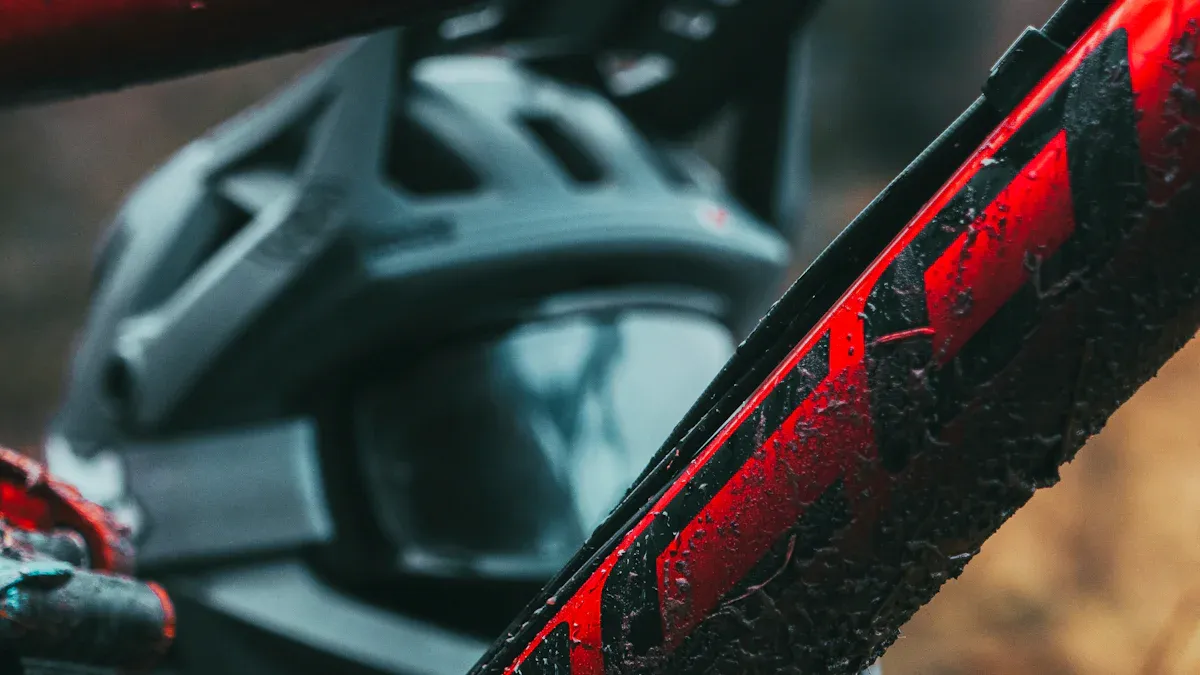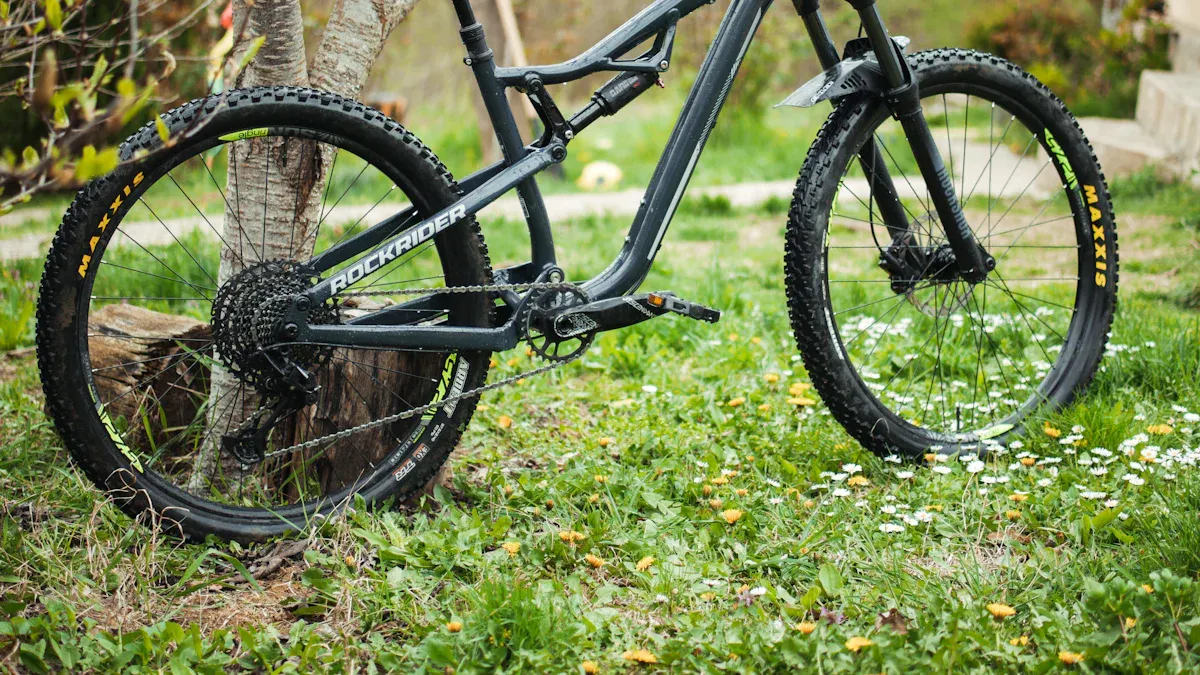
Choosing the right rear bike frame is very important for mountain biking. In 2025, more people want to buy them. The market is expected to reach US$ 12.65 billion. This growth is because of health awareness and outdoor fun. New technology, like high-pivot suspension designs, helps performance on bumpy trails. These new features make your ride more stable. They also help you ride trails with confidence. Picking the right frame makes you more comfortable. It also makes your overall riding experience better.
Key Takeaways
Picking the right rear bike frame makes mountain biking better. Think about how you ride and the trails you want to try.
Hardtail frames are good for cross-country riding. They are stable, respond quickly, and are usually lighter. This makes them great for different terrains.
Full suspension frames give comfort and control on bumpy trails. They soak up shocks, help with grip, and lower tiredness. This lets you ride longer.
Electric mountain bikes (e-MTBs) mix regular biking with electric power. They are flexible and comfortable, making them good for many terrains.
The material of the frame is important. Carbon fiber is lighter and handles bumps better. Aluminum is cheaper and lasts longer. Pick what fits your needs.
Hardtail Rear Bike Frames

Hardtail Features
Hardtail rear bike frames are very popular with mountain bikers. They are especially liked by those who enjoy cross-country riding. These frames have many benefits that make them special. Here are some important features of hardtail frames:
Frame Geometry: The shape of a hardtail frame affects how it rides on trails. Many hardtails are built for stability and quick response. This makes them great for different riding styles.
Front Fork Suspension: Hardtails usually have a front suspension fork. This fork helps absorb bumps and roots, improving your ride. Short travel forks are good for cross-country, while longer ones are better for tough trails.
Wheel Size: Most hardtails have either 29-inch or 27.5-inch wheels. Bigger wheels roll over obstacles easier, while smaller wheels are better for turning.
Tires: The standard tire width is about 2.4 inches. Wider tires give better grip on rough ground. Tubeless setups help reduce weight and avoid flats.
Drivetrain: Many hardtails use a 1x drivetrain. This makes shifting gears and maintenance easier. Some models still have a 2x system for riders who want more gear choices.
Brakes: Hydraulic disc brakes are common on hardtails. They provide strong stopping power in different conditions.
These features help improve the performance and strength of hardtail frames. This makes them a great choice for many riders.
Best Hardtail Models
When picking the best hardtail rear bike frame, some models are better in 2025. Here are a few top choices:
Specialized Stumpjumper EVO: This model is known for being versatile and performing well. It has a lightweight frame and great geometry. This makes it good for climbing and going downhill. The Stumpjumper EVO is popular with cross-country racers and trail riders.
Trek Procaliber: This bike is fast and efficient. Its IsoSpeed decoupler helps it handle rough terrain while keeping a stiff frame for power. It’s great for racing or long rides.
Cannondale F-Si: This hardtail is made for speed. It’s lightweight and has a special Lefty fork that improves handling. The F-Si is perfect for competitive riders wanting an advantage on trails.
Santa Cruz Highball: Known for being strong, the Highball is a good choice for aggressive riders. It has a stiff frame that works well for climbing and tricky sections.
Giant XTC Advanced: This model has a carbon frame that balances weight and strength. It’s made for cross-country racing, giving great acceleration and quick response.
These hardtail models not only perform well but also have features that improve durability and comfort on trails. Whether you’re racing or just having fun, these bikes can make your mountain biking experience better.
Full Suspension Rear Bike Frames

Full Suspension Benefits
When you ride on trails, a full suspension rear bike frame can really help, especially on tough paths. These frames have a rear shock that softens bumps and hits, giving you a smoother ride. Here are some main benefits of full suspension frames:
Benefit | Description |
|---|---|
Comfort | Advanced shock systems give a soft ride, reducing stress on your body. |
Traction | The suspension keeps your tires on the ground, improving grip on tricky paths. |
Control | Better stability helps with turning and going down steep trails. |
Performance | Great power transfer reduces energy loss, making rides more efficient. |
Reduced Fatigue | The suspension absorbs shocks, allowing for longer rides without pain. |
With these benefits, you can handle rough trails with ease. Full suspension bikes are great for grip on loose or rocky ground. You’ll see that riding on tough trails gets easier, as the rear suspension takes in impacts, letting you focus on where to go. Plus, you’ll enjoy better turning and going downhill, making your rides more fun.
Top Full Suspension Picks
Now that you know the benefits, let’s check out some of the best full suspension rear bike frames for 2025. Here are two top models:
Trek Fuel EX: This bike is known for being flexible. It has a balanced suspension system that works well on both climbs and descents. The Fuel EX is great for riders who want a bike that can handle different terrains without losing comfort or control.
Revel Rascal: The Rascal is famous for its amazing suspension performance. It improves climbing and going downhill, making it popular among mountain bikers. Its CBF suspension design offers efficiency and grip, giving you an advantage on the trails.
Both of these models are known for their performance and value. The Revel Rascal, in particular, is praised for its climbing and descending skills, making it a strong choice against other full suspension bikes, like the Trek Fuel EX.
When picking a full suspension rear bike frame, think about how you plan to ride. If you’re facing tough trails, these models will give you the comfort and control you need to enjoy your adventure.
Electric Mountain Bike Frames
Electric mountain bike frames are becoming popular with riders who want to ride on different terrains. These bikes mix the excitement of mountain biking with the extra power of an electric motor. Here are some main benefits of electric frames:
Versatility: Electric mountain bikes (e-MTBs) work well on many terrains. Whether you are climbing steep hills or going over rocky paths, the electric help keeps your speed and control.
Comfort: Many e-MTBs have lightweight carbon frames. These frames make your ride more comfortable, especially on bumpy surfaces. You will feel less tired during long rides.
Suspension Options: Full-suspension models handle all terrains well. They soak up shocks and bumps, making your ride smoother. Hardtail models cost less but may not be as comfy on rough trails.
Travel Range: Bikes with 140-160mm of travel are good for both uphill and downhill rides. This range is perfect for mixed terrain, letting you enjoy different trails without worrying about how they perform.
When you think about getting an electric mountain bike, look for features that boost performance and battery life. Here are some important things to remember:
Frame Material: Lightweight aluminum or carbon frames help with speed and efficiency.
Suspension Type: For tough terrains, a full-suspension carbon fiber frame gives better control and comfort.
Fit and Geometry: Choose a frame that fits you well. Comfort is important for long rides.
Motor and Battery Integration: Many new e-MTBs blend the motor and battery systems into the frame design nicely.
Now, let’s look at some recommended electric mountain bike models for 2025:
Model Example | Price Est. | Key Highlight | Key Specs |
|---|---|---|---|
~$2,899 | Long Range & Suspension Value | 500W Mid-drive Motor, 720Wh Battery, RockShox Full Suspension, 10-Speed Shimano Drivetrain | |
Canyon Spectral:ON CF 8 | ~$6,000 | Performance per Dollar | N/A |
Specialized Turbo Levo Pro | ~$11,000 | Top-Tier Tech & Integration | N/A |
These models are known for their performance and features. The Leoguar Trailblazer, for example, gives a great mix of power and comfort, making it a good choice for many trails.
With more e-MTBs, you will see that more riders enjoy longer rides without getting too tired. The UK market has changed a lot, with e-MTBs becoming more popular while regular bike sales have dropped. This shows that more people are seeing the benefits of electric mountain biking.
Frame Materials
When you pick a mountain bike frame, the material matters a lot. It can change how you ride. Let’s look at the three main materials: carbon fiber, aluminum, and steel.
Carbon Fiber vs. Aluminum
Carbon fiber and aluminum are the most common choices for mountain bike frames. Here’s a quick look at their features:
Feature | Carbon Fiber | Aluminum |
|---|---|---|
Weight | Heavier than carbon | |
Cost | Usually costs more | More budget-friendly |
Ride Comfort | Better at absorbing bumps, smoother | Stiffer, feels more trail impact |
Torsional Stiffness | Stiffer, transfers power better | Less stiff, can bend under pressure |
Durability | Stronger for its weight, absorbs hits | Can get stress cracks over time |
Lifespan | Lasts longer without breaking down | May develop cracks over time |
You’ll see that carbon fiber frames are lighter and give a smoother ride because they absorb vibrations well. But they cost more. Aluminum frames are heavier but cheaper and can handle rough rides better, making them a good choice for many riders.
Steel Frame Considerations
Steel frames have their own benefits. They are known for being strong and good at absorbing shocks, which makes for a comfy ride. Here are some things to think about:
Weight: Steel frames are usually heavier than both carbon and aluminum. This can make climbing harder but gives stability when going downhill.
Durability: Steel is tough and handles impacts well. It’s less likely to get stress fractures like aluminum.
Ride Quality: Steel does a great job of reducing vibrations, leading to a smooth ride, especially on bumpy trails.
Even though steel frames are not as popular as carbon or aluminum, they offer a classic feel and reliability that many riders like.
In 2025, aluminum makes up about 37% of the market, while carbon fiber is growing fast. Steel frames are not as common but still have fans who value strength and comfort. Choosing the right material depends on your riding style, budget, and the kind of trails you ride.
By knowing these differences, you can make a smart choice that improves your mountain biking experience. Whether you care more about weight, comfort, or durability, understanding your options helps you find the best frame for your rides.
Compatibility of Rear Bike Frames
When you pick a rear bike frame, compatibility is very important. You need to make sure your frame fits well with your wheels and other parts. Let’s look at two main things: wheel size compatibility and other factors to think about.
Wheel Size Compatibility
The size of your bike wheels can change how you ride. Different wheel sizes affect comfort, stability, and speed. Here’s what you should know:
Common Sizes: Most mountain bikes have either 27.5-inch or 29-inch wheels. Each size has its good and bad points. For example, 29-inch wheels go over obstacles easier, while 27.5-inch wheels are better for turning.
Performance Impact: While skilled mountain bikers might not see a big difference in performance during cross-country rides, wheel size can still change your overall experience. Picking the right setup can improve handling and speed, making your rides more fun.
Other Compatibility Factors
Besides wheel size, many other factors matter for compatibility. Here’s a quick look at what to think about:
Compatibility Factor | Description |
|---|---|
This is the distance between the dropouts. It changes by bike type, with common sizes like 135mm, 142mm, and 150mm. | |
Axle Size | The width of the axle that fits through the frame. Common sizes are 12mm and 15mm. |
Rear Derailleur Mounting | Make sure your derailleur fits the frame’s hanger. Most derailleurs use a standard bolt size. |
Derailleur Length | This depends on your cassette. Longer cages can handle wider gear ranges. |
Clutch Mechanism | A clutch helps keep the drivetrain stable and makes it easier to remove the wheel. |
Speed Compatibility | Your frame must match the chain and cassette speeds, whether it’s 8, 9, 10, or 11 speeds. |
By thinking about these factors, you can make a better choice when picking your rear bike frame. Compatibility makes sure your bike works well and fits your riding needs.
Choosing the right rear bike frame is very important for your mountain biking trips. Think about how you ride and the trails you will use. Here are some important points:
Category | Key Features |
|---|---|
Entry-Level | Focus on safety and being reliable, made to last. |
Mid-Range | Big improvements in performance for different trails. |
High-Performance | Light parts for racing and tough riding. |
Remember, a bike that fits well makes you more comfortable and helps you ride better. Your bike should fit your needs and the kind of trails you ride on. Enjoy biking! 🚴♂️
FAQ
What should I think about when choosing a rear bike frame?
When you choose a rear bike frame, consider your riding style, the type of trails, and how comfortable it feels. Also, think about what the frame is made of, the type of suspension, and if it fits your wheels and other parts.
How can I take care of my bike frame to make it last?
To keep your bike frame strong, clean it often, look for cracks, and make sure all parts are tight. Store it in a dry spot to stop rust and damage.
Can I change my bike frame later?
Yes! You can change your bike frame later. Just make sure the new frame works with your current parts, like wheels and gears.
What’s the difference between hardtail and full suspension frames?
Hardtail frames do not have rear suspension. This makes them lighter and better for climbing. Full suspension frames give more comfort and control on rough trails by absorbing bumps well.
How can I tell if my frame fits me?
To check if the frame fits, stand over the bike. You should have 1-2 inches of space. When you sit, your arms should reach the handlebars easily, and your legs should stretch a little when pedaling.
See Also
New Developments in Electric Bicycle Frames for 2025
The Advantages of Carbon Frames for Cyclists in 2025
Transformative Changes in MTB Frame Designs for Better Rides
Moving Beyond Lugged Steel Frames in Mountain Bike Designs
Comparing Fat Bike Frames and Mountain Bike Frames Differences
